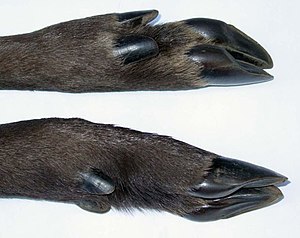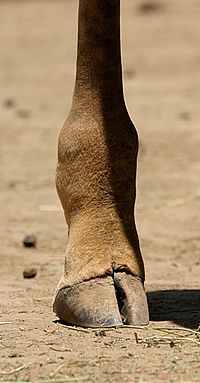Hoof


A hoof is the tip of a toe of an ungulate mammal, strengthened by a thick horny (keratin) covering. The hoof consists of a hard or rubbery sole, and a hard wall formed by a thick nail rolled around the tip of the toe. The weight of the animal is normally borne by both the sole and the edge of the hoof wall. Hooves grow continuously, and are constantly worn down by use. "Hoof" is Template:PronEng or /hʊf/; the plural is either hooves (Template:PronEng or /hʊvz/), or hoofs (/hʊfs/).
Most even-toed ungulates (such as sheep, goats, deer, cattle, bison and pigs) have two main hooves on each foot, together called a cloven hoof. Most of these cloven-hoofed animals also have two smaller hoofs called dew-claws a little further up the leg – these are not normally used for walking, but in some species with larger dew-claws (such as deer and pigs) they may touch the ground when running or jumping, or if the ground is soft. Other cloven-hoofed animals (such as giraffes and pronghorns) have no dew claws. In some so-called "cloven-hoofed" animals such as camels, there are no hooves proper – the toe is softer, and the hoof itself is reduced to little more than a nail.
Some odd-toed ungulates (equids) have one hoof on each foot; others (including rhinoceroses, tapirs and many extinct species) have (or had) three hoofed or heavily nailed toes, or one hoof and two dew-claws. The tapir is a special case, with three toes on each hind foot and four toes on each front foot.
The number of toes is considered in determining the kosher status of the animal's flesh.
